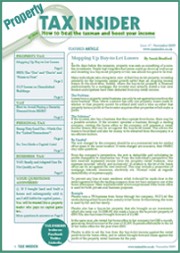Before you go, sign up to our free tax saving email course. Get 7 top property tax saving strategies in your email inbox that will help you save thousands in tax. Unsubscribe any time.
 Lee Sharpe warns that HMRC proposes to remove a vital component of the private residence relief capital gains tax rules, as a knee-jerk reaction to fears of rising house prices. Lee Sharpe warns that HMRC proposes to remove a vital component of the private residence relief capital gains tax rules, as a knee-jerk reaction to fears of rising house prices.This article looks at HMRC’s proposal to remove the taxpayer’s power to nominate which is his or her main residence, in order to benefit from capital gains tax (CGT) private residence relief. The oligarchs are coming! While it may not exactly be news that a few ‘ultra-rich’ foreign businessmen can dictate government policy, it is arguably less common that they do so accidentally. There have been many stories in the press about how the house prices in prestigious areas of London are rising very quickly, to the point at which they are affordable to only a tiny percentage of wealthy people – epitomised by so-called oligarchs. Some politicians are apparently concerned that this is causing the housing market to overheat, pushing up prices throughout London and beyond to unaffordable levels – at least for their voting constituents. HMRC and politicians have found common cause: HMRC’s concerns are that currently, individuals who are not UK tax-resident pay no CGT when they sell most UK assets, which is unfair to UK-resident taxpayers. But this is about to change and, unfortunately, it seems HMRC’s cure may well be worse than the disease. Why should we care? Of course, few of our readers are likely to be foreign billionaires: in truth, there simply aren’t that many around. However, earlier last year, HMRC issued a consultation document ‘Implementing a CGT Charge on Non-Residents’. It proposed to make individuals who are not tax-resident in the UK liable to CGT on their residential property/ies. Again, so what? The problem, as with so much of what HMRC does, is in the detail. HMRC realised that some overseas investors could nominate (say) their Knightsbridge apartment as their ‘only or main residence’ for CGT purposes, so that the specified property was effectively exempt from CGT anyway. So, their consultation proposed to do away with the power to nominate, altogether, from April 2015. Flipping outrageous! The power to nominate which property is your main residence was introduced with CGT in 1965, and is (for now at least) in TCGA 1992, s 222(5). As reported in Hansard at the time, the measure was to afford those taxpayers with more than one residence the choice of which should count as their CGT-exempt main residence for a particular period. HMRC wants to revoke the power to nominate and rely instead on a simple test – probably the one currently used when a nomination has not been exercised, which is to consider which is most used as the main residence. The power to nominate a main residence also allowed canny property investors to ‘flip’ homes in a rising market, by combining a main residence nomination with the rule that exempts the final period of ownership which, up until recently, said that if a property was your main residence at any time, then the last three years of ownership prior to sale would be exempt, even if you didn’t live there: Example: Main residence nomination
Three years ago, Ed bought a London apartment to live in, for £200,000; it is now worth £250,000. An opportunity to buy another apartment comes up, and he takes out a mortgage to buy it for £250,000, confident that both will continue to grow significantly in value, within the next couple of years. Ed nominates the second property as his main residence. He quickly ‘flips’ the nomination back to the first apartment, so he has up to three years (but see below) to sell the second (or indeed the first) apartment, entirely free of CGT – however large the return – because of the ‘final period of ownership exemption’. He sells the second flat 15 months later, for £280,000, pocketing a £30,000 gain, with no CGT. Had he sold the first property, there would have been a brief non-exempt period during which the second property was nominated, but this should be covered by the final period exemption if sold quickly, or Ed’s annual CGT exemption if sold later on. However, it’s not as simple as it looks: This is a sample article from the monthly Property Tax Insider magazine. Go here to get your first free issue of Property Tax Insider. |


 Tax Articles
Tax Articles